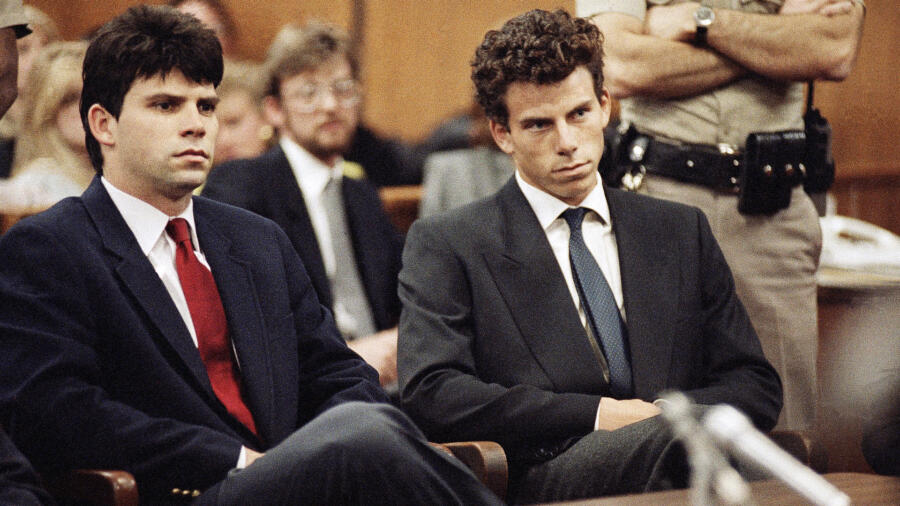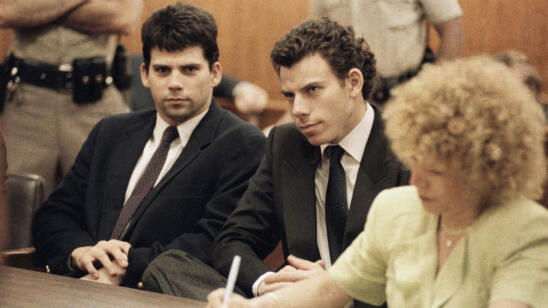At first glimpse, it looked like a rags-to-riches story turned tragic. Jose Menendez, a self-made Cuban-American businessman was shot repeatedly alongside his wife Kitty by a pair of 12-gauge shotguns in the den of their Beverly Hills, California home. One of their sons, Lyle, called 911 shortly before midnight on August 20, 1989, sobbing and telling the operator, “Somebody killed my parents!”
Early media speculation was that the killings might have been ordered by the mafia, or were related to Jose’s work in the home video business.
But in March 1990, authorities arrested and charged brothers Lyle and Erik—aged 22 and 19, respectively—setting the stage for the biggest parricide trial in American history. For four and a half months in 1993, America watched the proceedings unfold—gavel to gavel—on Court TV. In the end, each brother’s jury was unable to reach a verdict, and mistrials were declared.
The re-trial was staged in 1996, and was a more subdued affair, in no small part because Judge Stanley Weisberg banned television cameras from the courtroom, reducing the media frenzy. This time the juries came back with first-degree murder convictions, and each brother was imprisoned for life without the possibility of parole.
A&E True Crime looks back at some of the most memorable moments from the intriguing double-murder trial.
The Confession Tape
The prosecution had the proverbial smoking gun: an audiotaped confession that the brothers gave to a psychologist, Dr. Jerome Oziel. The tape—which is more than an hour long—made the brothers’ guilt in the murders unquestionable.
[Watch The Menendez Brothers: Sins of the Children on A&E Crime Central.]
“It was one of the most powerful moments in the trial for the prosecution,” Robert Rand, a reporter who covered both trials and wrote a book about the case, The Menendez Murders, told A&E True Crime.
“You hear the brothers talk about how they considered this for a few days. That’s premeditation. And Lyle says this horrible line,” in which he coldly laments the absence of his parents from his life, but expresses little remorse for the murders.
On the tape, Lyle Menendez is heard saying that “I think one of the big, biggest pains [Erik] has is that you miss just having these people around… I miss not having my dog around, if I can make such a gross analogy.”
The tapes made the brothers’ guilt in the shootings unquestionable: They may very well never have confessed otherwise.
But however bad the hour of tape was for the brothers, for the juries listening it was only one day of evidence, and the defense got to work discrediting it.
The Sideshow Soap Opera of the Psychotherapist’s Mistress
Police received word of the Menendez confession tapes from Judalon Smyth, who had been the mistress to Dr. Jerome Oziel—the therapist responsible for recording them. Smyth alerted the authorities to the tapes’ existence within days of their extramarital affair ending, claiming at the time that she had overheard the brothers’ admission from an adjacent room.
She later recanted that testimony and became a witness for the defense, saying that Oziel had orchestrated the taped confessions to have leverage over the wealthy murderous fraternal pair. She further maligned the psychologist’s character by claiming he had beaten and raped her, and that she feared he would have her killed.
The defense’s attempt to undermine Oziel’s credibility took a toll on the doctor. After being accused by a state panel of breaking confidentiality rules and having sex with female patients, he lost his license to practice psychology shortly after the end of the brothers’ second trial.
The ‘Abuse Excuse’
Much of the pretrial coverage of Erik and Lyle painted a picture of filial greed. That followed the prosecution’s narrative: They cast the brothers as cold-blooded unrepentant killers, noting how they went on massive shopping sprees between the murders and their arrests.
But a few weeks before their trial began, defense attorney Leslie Abramson revealed her planned defense to the Los Angeles Times: that the young men had been sexually molested by their father for years, and that the killings were tantamount to self-defense. She brought out over a dozen family friends to corroborate stories of parental emotional and sexual abuse, setting the stage for the brothers’ testimony.
It was a brazen gambit. Abramson would have to show that the brothers perceived an “imminent threat” to their bodily safety. The strategy was greeted with skepticism by some reporters, who saw it as a transparent attempt by spoiled rich kids to get away with a cold-blooded murder.
Then the brothers took the stand.
Lyle Menendez’s Tearful Testimony
It was clear the defense’s case would rest squarely on the power of the brothers’ testimony. That the first trial ended without a verdict speaks volumes to the strength of that testimony.
The defense questioned Lyle Menendez about the abuse he had endured. He burst into tears repeatedly while sharing graphic stories of severe incestual trauma. He ended up spending four days on the witness stand, but according to Rand, it was the first hour of his testimony that mattered most, an hour whose potency is difficult to appreciate through a TV screen.
“When you’re watching the TV feed, the camera is on the witness box,” Rand explains. “But in the courtroom the family members were crying, jurors were emotional. Some reporters were becoming emotional. That first hour of Lyle Menendez’s testimony was an absolutely pivotal moment. It just stunned the courtroom.”
Related Features:
What’s Next for the Menendez Brothers?
Was Sexual Abuse Behind the Menendez Brothers’ Murders?
Could New Revelations Lead to a New Trial for Erik and Lyle Menendez?
The Menendez Brothers and O.J. Simpson: Revealing Conversations Between Unlikely Jailhouse Friends


